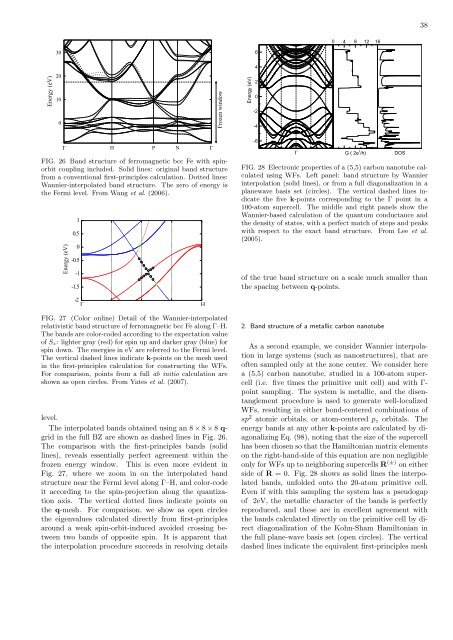Maximally localized Wannier functions: Theory and applications
Maximally localized Wannier functions: Theory and applications
Maximally localized Wannier functions: Theory and applications
You also want an ePaper? Increase the reach of your titles
YUMPU automatically turns print PDFs into web optimized ePapers that Google loves.
38<br />
0 4 8 12 16<br />
30<br />
6<br />
Energy (eV)<br />
20<br />
10<br />
0<br />
Frozen window<br />
Energy (eV)<br />
4<br />
2<br />
0<br />
-2<br />
-4<br />
Γ H P N Γ<br />
FIG. 26 B<strong>and</strong> structure of ferromagnetic bcc Fe with spinorbit<br />
coupling included. Solid lines: original b<strong>and</strong> structure<br />
from a conventional first-principles calculation. Dotted lines:<br />
<strong>Wannier</strong>-interpolated b<strong>and</strong> structure. The zero of energy is<br />
the Fermi level. From Wang et al. (2006).<br />
Energy (eV)<br />
1<br />
0.5<br />
0<br />
-0.5<br />
-1<br />
-1.5<br />
-6<br />
Γ<br />
G ( 2e 2 /h)<br />
DOS<br />
FIG. 28 Electronic properties of a (5,5) carbon nanotube calculated<br />
using WFs. Left panel: b<strong>and</strong> structure by <strong>Wannier</strong><br />
interpolation (solid lines), or from a full diagonalization in a<br />
planewave basis set (circles). The vertical dashed lines indicate<br />
the five k-points corresponding to the Γ point in a<br />
100-atom supercell. The middle <strong>and</strong> right panels show the<br />
<strong>Wannier</strong>-based calculation of the quantum conductance <strong>and</strong><br />
the density of states, with a perfect match of steps <strong>and</strong> peaks<br />
with respect to the exact b<strong>and</strong> structure. From Lee et al.<br />
(2005).<br />
of the true b<strong>and</strong> structure on a scale much smaller than<br />
the spacing between q-points.<br />
-2<br />
Γ<br />
H<br />
FIG. 27 (Color online) Detail of the <strong>Wannier</strong>-interpolated<br />
relativistic b<strong>and</strong> structure of ferromagnetic bcc Fe along Γ–H.<br />
The b<strong>and</strong>s are color-coded according to the expectation value<br />
of S z : lighter gray (red) for spin up <strong>and</strong> darker gray (blue) for<br />
spin down. The energies in eV are referred to the Fermi level.<br />
The vertical dashed lines indicate k-points on the mesh used<br />
in the first-principles calculation for constructing the WFs.<br />
For comparison, points from a full ab initio calculation are<br />
shown as open circles. From Yates et al. (2007).<br />
level.<br />
The interpolated b<strong>and</strong>s obtained using an 8 × 8 × 8 q-<br />
grid in the full BZ are shown as dashed lines in Fig. 26.<br />
The comparison with the first-principles b<strong>and</strong>s (solid<br />
lines), reveals essentially perfect agreement within the<br />
frozen energy window. This is even more evident in<br />
Fig. 27, where we zoom in on the interpolated b<strong>and</strong><br />
structure near the Fermi level along Γ–H, <strong>and</strong> color-code<br />
it according to the spin-projection along the quantization<br />
axis. The vertical dotted lines indicate points on<br />
the q-mesh. For comparison, we show as open circles<br />
the eigenvalues calculated directly from first-principles<br />
around a weak spin-orbit-induced avoided crossing between<br />
two b<strong>and</strong>s of opposite spin. It is apparent that<br />
the interpolation procedure succeeds in resolving details<br />
2. B<strong>and</strong> structure of a metallic carbon nanotube<br />
As a second example, we consider <strong>Wannier</strong> interpolation<br />
in large systems (such as nanostructures), that are<br />
often sampled only at the zone center. We consider here<br />
a (5,5) carbon nanotube, studied in a 100-atom supercell<br />
(i.e. five times the primitive unit cell) <strong>and</strong> with Γ-<br />
point sampling. The system is metallic, <strong>and</strong> the disentanglement<br />
procedure is used to generate well-<strong>localized</strong><br />
WFs, resulting in either bond-centered combinations of<br />
sp 2 atomic orbitals, or atom-centered p z orbitals. The<br />
energy b<strong>and</strong>s at any other k-points are calculated by diagonalizing<br />
Eq. (98), noting that the size of the supercell<br />
has been chosen so that the Hamiltonian matrix elements<br />
on the right-h<strong>and</strong>-side of this equation are non negligible<br />
only for WFs up to neighboring supercells R (±) on either<br />
side of R = 0. Fig. 28 shows as solid lines the interpolated<br />
b<strong>and</strong>s, unfolded onto the 20-atom primitive cell.<br />
Even if with this sampling the system has a pseudogap<br />
of 2eV, the metallic character of the b<strong>and</strong>s is perfectly<br />
reproduced, <strong>and</strong> these are in excellent agreement with<br />
the b<strong>and</strong>s calculated directly on the primitive cell by direct<br />
diagonalization of the Kohn-Sham Hamiltonian in<br />
the full plane-wave basis set (open circles). The vertical<br />
dashed lines indicate the equivalent first-principles mesh













